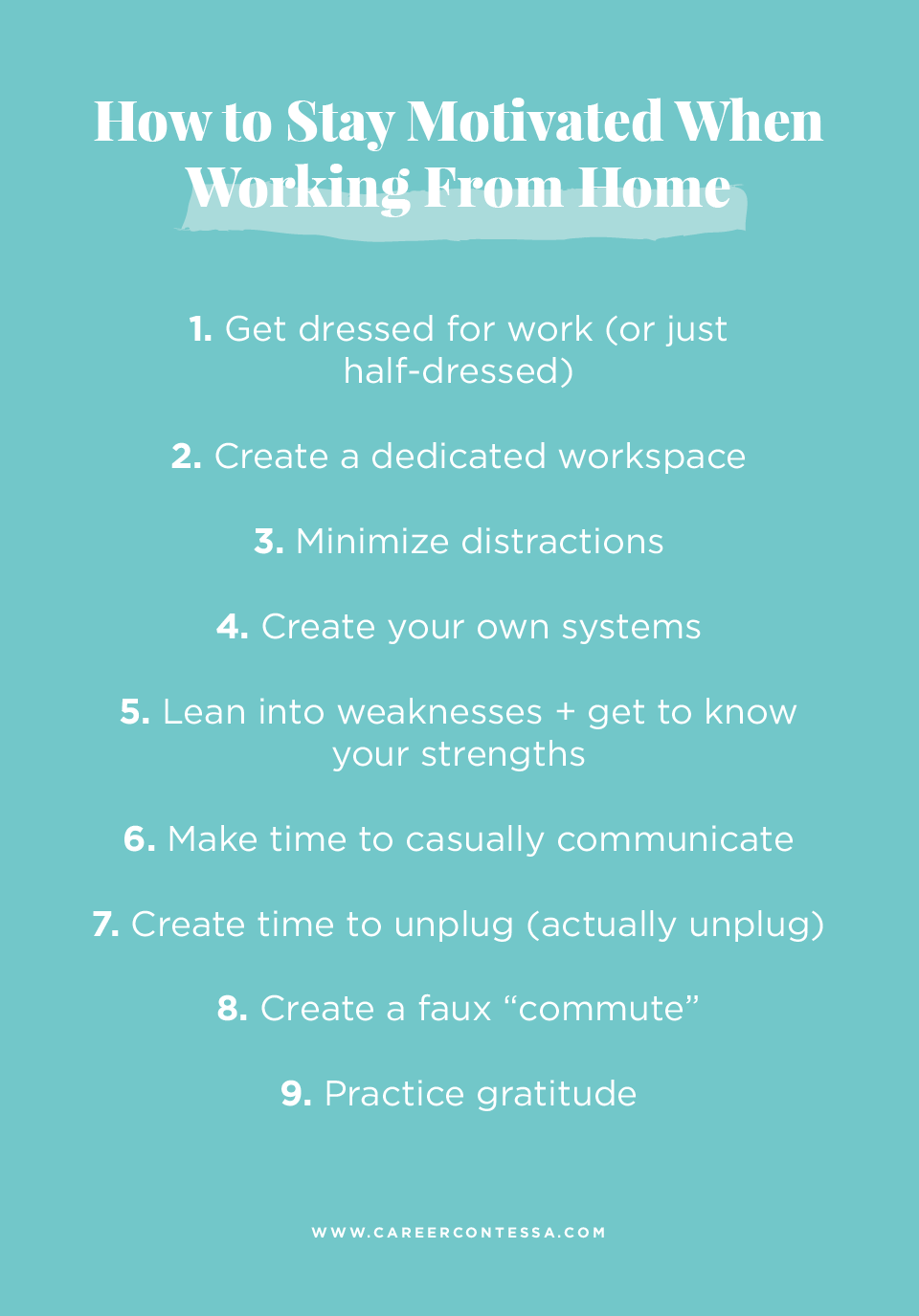How many days have you been working from home at this point? How are we supposed to stay motivated when every day is starting to look the same?
At the time of original publishing, we are in the midst of unprecedented social distancing. For the first time ever, everyone is sequestered to their homes for work, play, and everything in-between.
Depending on your current life situation, this might mean you’re working from home for the first time alone, alongside your roommates, with your partner, or with your rowdy children. While each of these situations is very different, there are some broad guidelines for
keeping your motivation while working from home.
We laid out nine ways to get (and hopefully) keep your motivation in a good place whether you’re in a temporary or permanent work from home situation.
Get Dressed for Work (or Just Half-Dressed)
When you’re working from home, especially in a time of crisis, we’re giving you full permission to embrace the outfit mullet. This is where you dress for the video chat—from the waist up. Now is the perfect time to embrace your leggings on the bottom look for maximum comfort.
But in all seriousness, working from home is not an excuse to sit around in your pajamas all day long. There is a lot of weight in morning time rituals—like getting dressed—and how they fuel your productivity throughout the day. Our first rule of cultivating motivation for remote life is just this: get dressed for work.
If it makes you feel more productive to dress up in
full business casual with your hair and makeup done, then do it. If comfort is paramount, go for the outfit mullet.
Create a Dedicated Workspace
This can be a tall order if you’re working out of a small apartment or a home that doesn’t have any space to spare. If this is the case, you can still create
a dedicated workspace, even if it’s in a small corner of your bedroom.
A dedicated workspace serves two main purposes:
- It is outfitted with all the things you need. Never have to search high and low for your headphones, notebook, or pen again. Your dedicated workspace will have everything you need. Eliminate a midday search for a notebook that turns into a trip to the bathroom that turns into you scrubbing the bathtub clean. See where we’re going with this one? Make sure your workspace is equipped—even if it means packing a bag to bring to the dining room table every morning.
- It’s your concentration space. We know, we know. There’s something dreamlike about the thought of working from your pillow-top mattress all day. Save your bed for catching Zs later on. Create a place where you work. If you can, make sure this dedicated workspace is different from where you sleep, eat, or binge Netflix. This way, when you’re in your workspace, you know you’re there to work.
Minimize Distractions
If you’re a mom working from home, we can hear you laughing at this suggestion. Distractions, especially when everyone is “working” from home, are difficult (or impossible) to avoid.
Instead, we want to minimize distractions where we can. This might mean establishing set schedules, setting (and rejiggering) expectations, and capitalizing on red zones of productivity.
What’s a productivity red zone? These are the times where you’re most productive due to minimized distractions, sleeping toddlers, help from a partner, or an overall quieter environment.
One great thing about working from home is that you can ride waves of productivity whenever they wash ashore. If you’re a working parent whose two-year-old naps at a certain time, use that quiet reprieve for phonecalls or dedicated work time. If you work best before the sun comes up—but found it socially unacceptable to arrive at the office that early—then use that time to your advantage.
Create Your Own Systems
Once you familiarize yourself with your optimal working times, a dedicated workspace, and a distraction-free space, create systems that work for you. This could mean setting up meeting times, communication methods, time tracking, and work documentation.
Find ways to make your work work for you. It’ll be different than your in-office setting. Create a schedule for yourself. Let it be pliable in the first weeks before finding what really works for your needs, your most productive times, your existing meetings, and your desired workflows.
Here are a few resources to help you “productify” your work from home life:
Lean into Your Weaknesses + Get to Know Your Strengths
In a typical 9-to-5 office setting, it’s pretty common to experience than 3 o’clock slump. You’ve finished a productive morning, held a few meetings, and even enjoyed a good lunch. This is the time where, for many employees, there’s a slump in energy and productivity. This is the hour where your eyelids can feel heavy and your motivation is at its weakest.
When working from home, get to know when your “slumpiest” times are—and use them for low-energy work, miscellaneous to-dos, or to take a much-needed break. Once you familiarize yourself with your most productive and least productive times, you can mold your workday around it. This is one major difference working from home offers from a traditional in-office environment. If you’re not “on” at a certain point of the day—barring any meetings or conferences—you can break off to recharge without being in the center of an open office.
Make Time to Casually Communicate
Even your favorite introverts can find working from home to be isolating over time. That’s because no Zoom meeting and no Google Hangout can replicate real human interaction, but we sure can try.
Human interaction is important—and we are learning that more and more as every day goes by. Our next tip is to schedule some human-to-human contact. We know this sounds clinical and counter-intuitive, but it can serve as a nice placeholder for that missed kitchen interaction or for the simple catching up you do while passing in the hallway.
Make simple 15-minute meetings to catch up with coworkers or your entire team. These meetings don’t even need to be about work—at all. Consider bringing a
few icebreaker questions to the meeting.
Create Time to Unplug (+ Actually Unplug)
When working from home, it can be difficult to really unplug. However, it’s crucial to do so. Your home should not have to become a 24/7 working space for you.
Once you’ve mastered your groove and identified your time of peak productivity, make sure you’re logging out, unplugging, and shutting work off. This can mean—quite literally—unplugging your computer, turning your phone on airplane mode, and setting an away message.
Make time to transform your home out of office mode and back into cozy home mode. Cuddle your dog. Check out what’s new on Netflix.
Create a Faux “Commute”
Let’s hear it for the best part of working from home—no commute!
No trains, no busses, no traffic, and no delays. No dealing with rainy mornings, defrosting your windshield, or dealing with other cranky commuters. When working from home, you can roll out of bed and log on while your coffee is still brewing.
What we mean when we say faux commute is simple. Go for a morning walk or take a few minutes to stretch things out on a yoga mat before you start your workday. End your workday on this note, too. You can mark the beginning and the end of your workday with an active ritual that loosens your ligaments, gets your heart rate going, and separates your work life from the rest of your life.
The best part of this commute is that it costs nothing, involves no traffic, and is as long as you want it to be!
Practice Gratitude
As we are compiling this article, we are in the middle of the Coronavirus pandemic. Every day, we are learning new things about how to go forward—with our careers, our relationships, and with great regard to the most important thing of all, our health. Nobody has all of the answers, so we do our best to traverse with care.
- While it can be a drag to be cooped up in your home, be grateful you have a roof over your head.
- While your toddler might be driving you to the brink with hundreds of questions, be grateful they are healthy enough to do so.
- While your partner’s mere breathing might be annoying you at this point, be grateful they are beside you.
- While it can seem nearly impossible to focus on work when everything else seems more important, be grateful you are still employed.
It’s always fine to feel frustrated, cheated, or unlucky, try your best to balance your moments of dissatisfaction with gratitude.
Finally, please stay safe and healthy.














